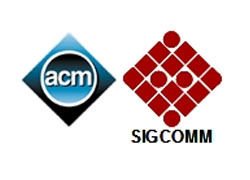ACM Special Interest Group on Data Communication Annual Conference on the applications, technologies, architectures, and protocols for computer communication (ACM SIGCOMM 2011), Toronto, Ontario (Canada)
 Access networks include modems, home gateways, and DSL Access Multiplexers (DSLAMs), and are responsible for 70-80% of total network-based energyconsumption. In this paper I'll take an in-depth look at the problem of greeningaccess networks, identify three root problems, and propose practical solutionsfor their user- and ISP-parts. On the user side, the combination of continuous light traffic and lack of alternative paths condemnsgateways to being powered most of the time despite having Sleep-on-Idle (SoI) capabilities. To address this problem, we introduce Broadband Hitch-Hiking(BH2), that takes advantage of the overlap of wireless networks to aggregate user traffic in as few gateways as possible. In current urban settings BH2can power off 65-90% of gateways. Powering off gateways permits the remaining ones to synchronize at higher speeds due to reduced crosstalk from havingfewer active lines. Our tests reveal speedup up to 25%. On the ISP side, we propose introducing simple inexpensive switches at the distribution frame forbatching active lines to a subset of cards letting the remaining ones sleep. Overall, our results show an 80% energy savings margin in access networks.The combination of BH2 and switching gets close to this margin, saving up to 69%.
Access networks include modems, home gateways, and DSL Access Multiplexers (DSLAMs), and are responsible for 70-80% of total network-based energyconsumption. In this paper I'll take an in-depth look at the problem of greeningaccess networks, identify three root problems, and propose practical solutionsfor their user- and ISP-parts. On the user side, the combination of continuous light traffic and lack of alternative paths condemnsgateways to being powered most of the time despite having Sleep-on-Idle (SoI) capabilities. To address this problem, we introduce Broadband Hitch-Hiking(BH2), that takes advantage of the overlap of wireless networks to aggregate user traffic in as few gateways as possible. In current urban settings BH2can power off 65-90% of gateways. Powering off gateways permits the remaining ones to synchronize at higher speeds due to reduced crosstalk from havingfewer active lines. Our tests reveal speedup up to 25%. On the ISP side, we propose introducing simple inexpensive switches at the distribution frame forbatching active lines to a subset of cards letting the remaining ones sleep. Overall, our results show an 80% energy savings margin in access networks.The combination of BH2 and switching gets close to this margin, saving up to 69%.
 Descargar la publicación (966 Kb)
Descargar la publicación (966 Kb)

